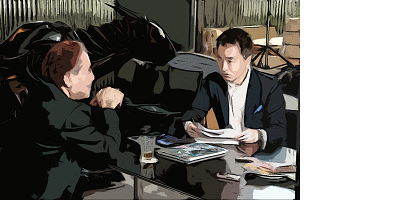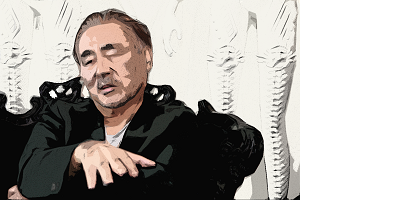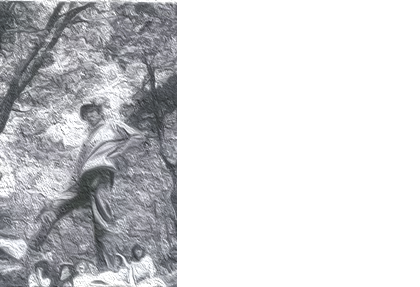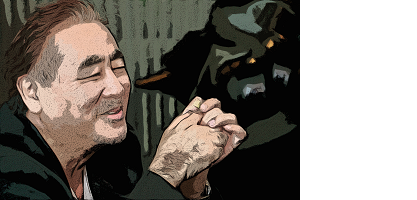~How a Boy Who Loved to Draw Joined Tatsunoko Productions~
2018.05.20

https://d2wi3xvhr3qrd7.cloudfront.net/wp/wp-content/uploads/2018/05/17213209/04_056_r-1083x846.jpg
Entertainment, which includes music, movies, and games, was born along with the history of mankind, has been loved by the times, and has undergone change and evolution. There are passionate people who created, nurtured, and led them to maturity. This is a biography of different people in entertainment, focusing on these great and different people and introducing them in the form of interviews.
Born in Shizuoka, a boy who loved to draw left for Tokyo after graduating from junior high school. In Tokyo, he started working in TV animation under the late Tatsuo Yoshida, the founder of Tatsunoko Productions. With the development of Japanese television animation, which was in its infancy at the time, the boy grew up and began to express his own worldview to the world, which he continues to do to this day.
The boy's name is Yoshitaka Amano.
His gorgeous colors go beyond Japan to the world, his unique taste transcends categories and fuses with various cultures, and his worldview still embodies his insatiable quest.
This edition of "Entame Ijinden" explores the roots of Yoshitaka Amano's sense of entertainment and his passion for creativity, and examines the motivations that drive him.
I had never thought of painting as a career at all.
You were born in Shizuoka, but which part of Shizuoka are you from?
It's Shizuoka City.
What was it that got you interested in illustration and animation?

https://d2wi3xvhr3qrd7.cloudfront.net/wp/wp-content/uploads/2018/05/17202442/MG_3382_r.jpg
I also drew what we would now call "mecha," such as submarines and airplanes.
However, I was more interested in people, the kind of illustrations that Shigeru Komatsusaki (Note 1) and Soji Yamakawa (Note 2) often drew in the shonen magazines of the time, and I think I drew more realistic things like that.
Note 1: A painter and illustrator active from the early Showa period to the Heisei period. He created many illustrations for war stories in boys' magazines such as "Shonen Magazine" and "Shonen Sunday," as well as illustrations of airplanes and warships. His work is still highly regarded today, and he is known as the "master of fantasy science illustrations.
Note 2: An illustrator whose popularity was divided between Shigeru Komatsuzaki. His "Shonen Kenya" serialized in the magazine Shonen Club was highly popular and was made into an anime. Other representative works include "Shonen Ohja" and "Boy in the Wilderness".
That's right. There were many, weren't there? Did you like that kind of art?
Yeah.
How were the manga and other books?
I watched manga, but I didn't really draw them. I was more interested in realistic things.
So, were you influenced by Mr. Komatsusaki and others at that time, and did you decide that you wanted to make painting your career?

https://d2wi3xvhr3qrd7.cloudfront.net/wp/wp-content/uploads/2018/05/17202914/MG_3502_r.jpg
I don't think I was thinking about making a career out of it at all. I just drew because I liked it. I have two older brothers. At the time, my older brother was working in a paper factory, or something related to paper. So he brought me a big piece of paper. So he brought me a big piece of paper and I drew on it.
From that time on, you had an environment where you could express yourself on a large piece of paper, a canvas.
I still do. I draw on top of the paper (laughs). It hasn't changed much.
So you must have had a slightly different sensibility from the other children around you?

No, we played together quite a bit. Neighbourhoods friends, schoolmates, and so on. But when I was painting, it was like a special occasion. I don't remember, but my mother told me that I didn't make plans to play when I was painting, or I would say something like, "I'm painting today," and then refuse. I guess I was like that. But other than that, I was just a normal kid.
Did you concentrate on drawing only when you were drawing?
It might have been.
The last place I went was Tatsunoko Production.
At that time, the subject of the painting was still people?
I guess so. I don't think I was more interested in drawing flowers or the sky. I was drawing illustrations, or something with a story.
So that's when it started, I see.
I mean, all I had around me were manga magazines and things like that. I didn't have any art books. I think I drew from the things I came across in those magazines.

https://d2wi3xvhr3qrd7.cloudfront.net/wp/wp-content/uploads/2018/05/17202643/MG_3346_r.jpg
And then, at the young age of 15, you joined Tatsunoko Production (Tatsunoko). How did that happen?
I had a childhood friend who lived in my neighborhood. We were best friends, but when I was in the third or fourth year of elementary school, he moved to Tokyo for his parents' reasons. But his grandfather's house was in Shizuoka, so he would come home for summer vacation. That's how I started to get information about manga and other things in Tokyo. I started reading Osamu Tezuka's "How to Draw Manga" (Note 3) and Shotaro Ishinomori's "Manga-ka Nyumon" (Note 4), and became interested in manga. So from about the first year of junior high school, I started to draw some manga. During the winter vacation of my third year of junior high school, I went to Tokyo for the first time, and my friend's house was in Kokubunji.
Note 3: An introductory manga book for children in which Osamu Tezuka explains in simple terms how to draw basic manga. Many manga artists say they learned how to draw manga through this book.
Note 4: An introductory manga book published in 1965 by Shotaro Ishinomori (then known as Shotaro Ishimori). It introduces everything from the art materials and tools used to how to compose a story and screen to how to publish a work. It became the bible for aspiring manga artists of the time.
Yes, it's Kokubunji.

https://d2wi3xvhr3qrd7.cloudfront.net/wp/wp-content/uploads/2018/05/17202444/MG_3386_r.jpg
At that time, there were a lot of manga artists living in Kokubunji. So we decided to go visit some of these places. The last place I went was Tatsunoko Production. They were an animation company, and at the time they were airing a show called "Space Ace" (Note 5), which I was a fan of. I thought, "Wow," and wanted to go there and have a look. But I don't remember exactly, but I think it was New Year's Day, so they were closed. I think it was during the vacations. The company didn't start until after New Year's, and school was about to start. But we decided to go for a visit. So I thought I'd draw a picture for them to see, so I drew it at my friend's house and brought it with me. That's how it all started.
Note 5: A science fiction adventure about Ace, a boy from the planet Parum who drifts to Earth in the 21st century and takes on bad guys and monsters. It was Tatsunoko Pro's first animation work and was aired from 1965 to 1966.
I hadn't thought about entering the world of painting at all.
So it was just in time for the winter break to end. So you didn't go to school at all?
I think I skipped a day or so. I guess that's when I said something like "I want to join this company." and they let me have a tour. I don't really remember, but I think I told them.
So, after I returned to Shizuoka, I received some kind of employment notice. I thought, "What am I going to do now? I hadn't thought about entering the world of painting at all.
You didn't think of that?
Actually, yes. Of course, when I went to Tatsunoko, I probably said that I wanted to do that kind of work, and I think that's how it happened. So I guess I just went there without a second thought.

https://d2wi3xvhr3qrd7.cloudfront.net/wp/wp-content/uploads/2018/05/17202726/MG_3400_r.jpg
Is that so. By the way, what kind of pictures did you bring to Tatsunoko at that time?
I don't remember it at all.
You don't (laughs).
No. But that was the beginning of it all, yes.

https://d2wi3xvhr3qrd7.cloudfront.net/wp/wp-content/uploads/2018/05/17202912/MG_3486_r.jpg
But at the age of 15, it seems like you made a very ambitious decision. What did you actually think about it?
It was a great feeling.
I was shocked and thought, "Oh, I'm all alone".
Was it because you wanted to go to Tokyo?

https://d2wi3xvhr3qrd7.cloudfront.net/wp/wp-content/uploads/2018/05/17202535/MG_3323_r.jpg
No, I didn't want to go to Tokyo at all. I wanted to stay with my parents in Shizuoka if possible. But there was a place where I could draw pictures. Also, at the time, animation was a new thing. I thought it was cutting edge, and the pictures were really beautiful.
So, how did you feel when you actually joined Tatsunoko? Was it tough, or was it a little different from what you thought the world would be like?
I still remember the night before I went to work for the first time. In the mulberry field, there was a dormitory of sorts.
Tatsunoko's dormitory.

https://d2wi3xvhr3qrd7.cloudfront.net/wp/wp-content/uploads/2018/05/17202446/MG_3394_r.jpg
Yes, so my brother, who was in Tokyo, came to the dormitory with my eldest son in Shizuoka. But, of course, everyone had left. I was left alone and thought, "What?" I thought. I was shocked and thought, "Oh, I'm all alone". I don't know how to describe it.
The feeling of loneliness I felt at that time is something I have as an original experience. And even though I'm in Tokyo, I'm in Kodaira. It's a pretty rural area (laughs).
There would have been nothing back then.
Still now, though (laughs). I wondered what was going on, but when I went to work the next day, my mind changed 180 degrees, and I thought, "This is fun!". After that, I never had that problem again.
At that time, were there any other 15-year-old workers besides you?
There were several of them.
As I recall, your colleagues were full of amazing people like Mr. Yoshiyuki Tomino (Note 6) and Mr. Kunio Okawara (Note 7), weren't they?
Note 6: An animation artist who has created many masterpieces such as "Triton of the Sea," "Mobile Suit Gundam," and "Space Runaway Ideon". He also worked as a freelance director for Tatsunoko productions such as "Judo Boy" and "The Adventures of Hutch the Honeybee".
Note 7: A master mecha designer known for his work on various robot and mecha designs, including the mobile suits of Mobile Suit Gundam. He has designed mecha for numerous Tatsunoko productions.

https://d2wi3xvhr3qrd7.cloudfront.net/wp/wp-content/uploads/2018/05/17202450/MG_3435_r.jpg
They came around after that. I think Mr. Tomino was still working for Mushi-Pro (Note 8) at that time.
Note 8: An animation production company established by Osamu Tezuka, officially named "Mushi Production". The company produced Japan's first animated television series, "Astro Boy" and its first color film, "Kimba the White Lion", but went bankrupt due to financial difficulties.
It was around the time of "Casshern" that I started to draw characters from scratch.
About your work at that time, was it more like drawing pictures of the work that the company got for you?

Kikitaka Amano 17 years old
First, there was a training period, and then I worked in animation, and then in original drawing.
When I was about 17 or 18 years old, I started to work as a character designer and animation director at the same time. Then, I gradually shifted my focus to characters. I was locked in a small room called the character room, and I started working there.
Is that where you created "Science Ninja Team Gatchaman" (Note 9) and "Casshan" (Note 10), which were representative of Tatsunoko at that time?
Note 9: Depicts the activities of the Science Ninja Team, a special unit of five boys and girls formed to fight against the evil secret society Galactor. A representative work of early Tatsunoko, it was a big hit for its unique characters, authentic science fiction world, and spectacular fighting action. It was aired from 1972 to 1974.
Note 10: The film depicts the battle of Casshern, who becomes an immortal artificial human to protect humans from the threat of the Andro Corps led by Viking Boss. It was aired from 1973 to 1974.
Oh, I didn't make "Gatchaman". It's just that Tatsuo Yoshida (Note 11) and other great people made it together, and I participated in it.
Note 11: The first president of Tatsunoko Productions. After working as a storyteller and manga artist, he established Tatsunoko Production in 1962. He produced many popular works such as "Science Ninja Team Gatchaman", and together with Toei and Mushi Productions, led the Japanese animation industry in its early days.
I see.

https://d2wi3xvhr3qrd7.cloudfront.net/wp/wp-content/uploads/2018/05/17202533/MG_3320_r.jpg
It was around the time of "Casshern" that I started to draw characters from scratch. While doing that, I also did some original drawings, and in the middle of the project, as I mentioned earlier, we created a character room. I don't remember exactly when that was.
No, I do as I'm told (laughs).
Yeah?
Most of Tatsunoko's works were original. There were no original works, so we had to create them from scratch. That's why not only us, but also the script writers had a planning and literature room. It's next door to the character room. So, there were people like Tatsuo Yoshida, Ippei Kuri (Note 12), and Genzo Toriumi (Note 13). Mr. Toriumi has since passed away, but he was originally a screenwriter in the movie business. Those people came up with the plan. They would create characters and stories, then put them together and go to present them to agencies and TV stations. That was the system we used. And then they would appear in the world as new works. There are many that don't come out, though.
Note 12: Yoshida Tatsuo's younger brother and second brother is Yoshida Kenji. He made his debut as a manga artist, but established Tatsunoko Production with Tatsuo and others.He has worked as a producer and director of various animated films such as "Science Ninja Team Gatchaman" and "The Genie Family".
Note 13: A pioneer in the field of screenwriting since the early days of anime, he has participated in Tatsunoko's works from the very beginning. After leaving Tatsunoko, he was in charge of composition and scriptwriting for "Ronin Warriors" and "Mister Ajikko," while also leading the scenario circle Ohtori-Koubou and putting effort into training younger artists.
So there were quite a few that didn't come out?

https://d2wi3xvhr3qrd7.cloudfront.net/wp/wp-content/uploads/2018/05/17202453/MG_3439_r.jpg
Yes, that's more often the case. Of course, I also worked in animation production. We had departments for backgrounds, original animation, and editing, and I worked there. In that sense, we are an animation production company, but we are also a planning company.
For example, did you have a worldview or a storyline in mind, and did you create the characters according to that? Or did you create them from your own imagination, or did you have your own way of doing things?
No, I do as I'm told (laughs).
Is that how it was back then.

https://d2wi3xvhr3qrd7.cloudfront.net/wp/wp-content/uploads/2018/05/17202526/MG_3312_r.jpg
Of course, the company has the right to make decisions, and the president, Tatsuo Yoshida, makes the final decision. For example, in the case of "Gatchaman," we decided to make it realistic, though I don't remember the details.
So we holed ourselves up in an inn or hotel and worked on it. Then, after about a week, we would compare the characters and the story, add and subtract things, and put it all together in a proposal. I think it was like that.
・・・
To be continued in Part 2.
<Original JP site: https://tokyo.whatsin.jp/221192>
